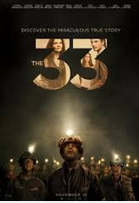 Many readers will remember the 2010 news reports of the Chilean miners: trapped underground for more than two months in the San Jose mine in the Atacama desert of northern Chile, and their dramatic rescue, one by one, while the world watched on television. Hector Tobar’s vivid account of the miners, the mine’s collapse, and the rescue “Deep Down Dark: The Untold Stories of 33 Men Buried in a Chilean Mine, and the Miracle That Set Them Free” has been retitled “The 33,” and re-released in preparation for a movie version coming in November.
Many readers will remember the 2010 news reports of the Chilean miners: trapped underground for more than two months in the San Jose mine in the Atacama desert of northern Chile, and their dramatic rescue, one by one, while the world watched on television. Hector Tobar’s vivid account of the miners, the mine’s collapse, and the rescue “Deep Down Dark: The Untold Stories of 33 Men Buried in a Chilean Mine, and the Miracle That Set Them Free” has been retitled “The 33,” and re-released in preparation for a movie version coming in November.
Tobar meticulously describes the miners, their families, their lives, and the mine. The miners’ lives are not easy, and they work in the mine because it pays well, allowing them to support their families: wives, children, and sometimes extended families. (At least one married miner split his time between his wife’s home and his girlfriend’s.) In the US we often think of miners as local, but the Chilean miners came from far and near the mine, working a week of 12-hour shifts at a time, then heading off again to homes as far as 36 hours away by bus.
The San Jose mine was a century old, and still yielded copper (40 pounds per metric ton of rock) and gold (less than an ounce). Its central passageway, the Ramp, was big enough for trucks. The miners entered at level 720, 720 meters above sea level. On the morning of the collapse miners were working at level 60, and some as low as level 40. There was a refuge area with food and cots at Level 90, often used as a break room, because fresh air was pumped into it from the surface. For several months before the collapse cracks had appeared in the Ramp but tests indicated the cracks were not growing. So the men went on working.
Getting the 33 out wasn’t the only miracle of the story. No one was killed or injured during the collapse. The trapped men were able to get to the refuge, and the people on the surface found them (that took two weeks). There was water – not fully clean water, but enough of it – where the trapped miners could get it. But the families had to pressure the mining company and the government to keep the search going, and they did so by camping near the mine entrance.
It’s tempting to treat the miners as heroes, and to project superhuman skills and values on to them but the men suffered, and they reacted in character. Some grabbed food, some shrank from leadership. One kept a diary. Throughout the book Tobar describes the men not, perhaps, as their best selves, but as men who had to behave as best they could in a group in order to survive.
Tobar’s story of life under the rock is vivid and gripping; it’s matched by his account of what went on above – the politics, the news stream, the psychological support and the missteps. “The 33” is a detailed and lively account resourcefulness and resilience, and very entertaining as well. Do you agree? Let us know in the comments.
Have a book you want me to know about? Email me at asbowie@gmail.com. I also blog about metrics at asbowie.blogspot.com.
